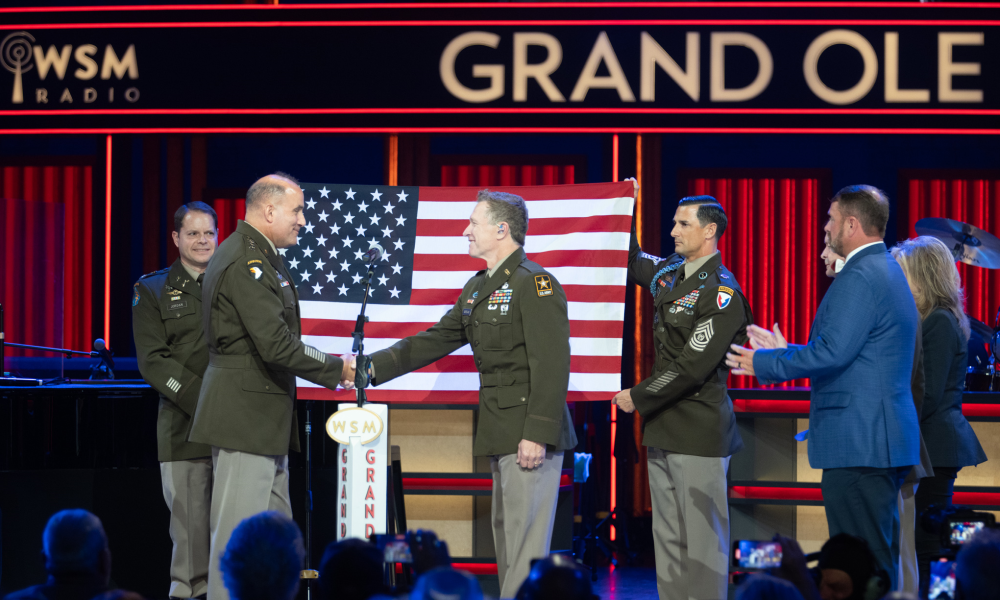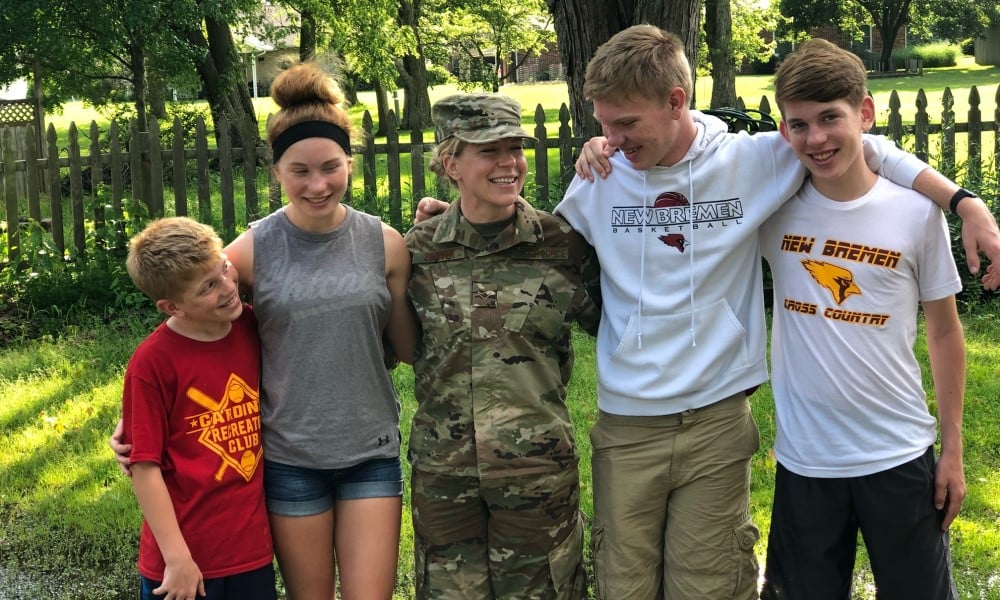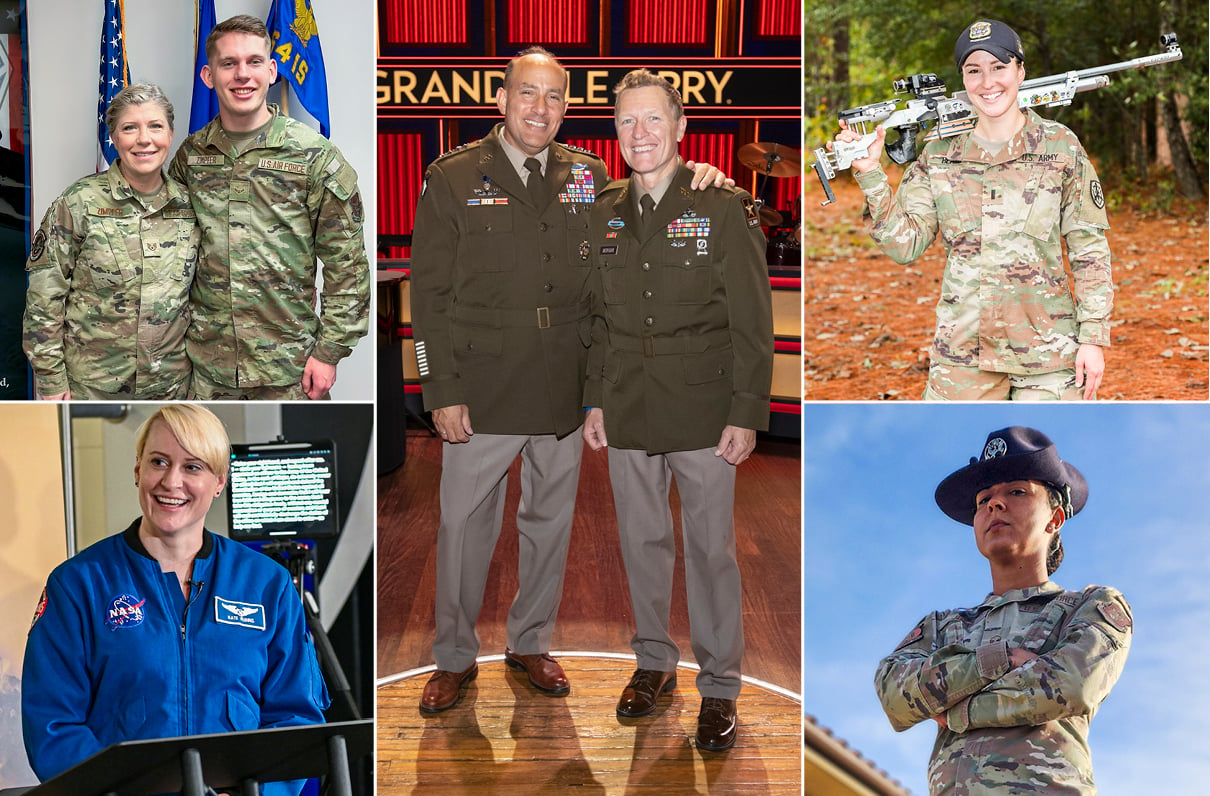(This article by Hope Hodge Seck originally appeared in the August 2024 issue of Military Officer, a magazine available to all MOAA Premium and Life members. Learn more about the magazine here; learn more about joining MOAA here.)
They gave me a green uniform and black boots for my feet,” country music artist Craig Morgan sang in his 2000 song “Paradise.”
“Eighteen and wild as hell, I thought it would be neat.”
But in 2023, when Morgan enlisted into the Army Reserve as a warrant officer in the middle of a live show at Tennessee’s Grand Ole Opry, he was a mature 59 — and he knew exactly what he was in for.
Previously an active duty Army forward observer who stepped away from his military career at the 17-year mark to pursue opportunities in music, Morgan (whose name tape reads Greer, his legal last name) now can embrace both as a bandmaster within the Army’s recruiting arm, while earning his longtime goal of a military retirement.
And he says he believes Americans like himself who are joining or returning to the military later in life hold great promise for the services — particularly as they contend with historic difficulties in attracting the younger recruits who have historically made up the lion’s share of the recruiting pool.
“I think it only benefits us to allow that to happen again, as long as they can pass the PT test,” Morgan, who has competed in Ironman triathlons and participated in the CBS adventure reality TV show Beyond the Edge, told Military Officer. “I think it’s imperative that we understand that our military needs to be a physically, mentally, emotionally, and spiritually stable group of people.”

Singer and Army veteran Craig Morgan enlists and is sworn into the U.S. Army Reserve during a live show at the Grand Ole Opry in July 2023. (Photo by Chris Hollo/Grand Ole Opry)
A New Recruiting Opportunity
The military services might be coming around to a similar point of view. While no service branch is accepting 59-year-olds off the street — Morgan had to receive an age waiver from the Army based on the value he was expected to provide to the service — the Air Force and Space Force raised the maximum age limit for enlistment from 39 to 42 in 2023. Recruiters could not immediately say how many previously excluded recruits have already joined up thanks to the new age policy, but officials said at the time they anticipate bringing in 50 new enlistees a year.
A 2022 report from the nonpartisan think tank RAND Corp. found recruits ages 25 to 35 made up 12% of all enlisted personnel between 2002-17. But though a small part of the whole, these older recruits, the study showed, were more likely to succeed in their first term than younger troops once they’d made it through the rigors and physical challenges of basic training. They were also more likely to want to join the National Guard and Reserve following active service, the report showed, and were perceived by recruiters as more focused and motivated than younger counterparts.
In an opinion piece for Defense One, RAND researchers Ryan Haberman and Michael S. Pollard argued the Army should shift its resources toward attracting these older recruits, noting the Army had temporarily increased its upper age limit to 42 between 2007 and 2016 to support the Iraq surge.
“Recruiters told us that older recruits were also more likely to walk into a recruiting station on their own without targeted outreach, indicating ample room for increased efforts to inform older individuals about Army opportunities,” they wrote. “In interviews with young soldiers, some even insisted that older recruits’ maturity made them better suited for military life.”
The recruiters who spoke with Military Officer said they’re also seeing more recent interest from older Americans in military opportunities, despite a recruiting system that doesn’t specifically target them. And late-joining Reserve members who shared their stories — including an astronaut and a world-class athlete, among others — say age hasn’t held them back at all.
[RELATED: Need for Accession Waivers Soars Amid Historic Recruiting Challenges]
Persistence and Focus
As Air Force Senior Airman Samara Traylor found, sometimes older recruits have to knock on a few doors to find a way in. By the time she reached her 30s, Traylor figured her chance at joining the military had passed. But a move to the military-friendly state of Texas and an encounter with an enthusiastic infantry soldier who said she wasn’t too old to start convinced her to apply to the Air Force Reserve at age 35.
But she encountered a problem right off the bat: She couldn’t get a recruiter to call her back. She didn’t give up. Eventually, she connected with Master Sgt. Donald Worster, a recruiter who had also returned to the Air Force later in life and was thrilled to bring Traylor in.
“I’m that person,” Traylor said. “I’ll keep knocking at that door until my knuckles bleed.”
In basic training at age 37, Traylor was quickly promoted to dorm chief, the highest leadership position among trainees, while adopting an informal role of “mother” to her younger peers. Today, she splits her time between roles as a personnel specialist at the 433rd Maintenance Group out of Joint Base San Antonio-Lackland, Texas, and a professional event coordinator in her civilian role.
Staff Sgt. Erin Zimpfer, also an Air Force reservist, contended with another challenge out of the gate: the ticking clock. In 2018, contending with the end of a 19-year marriage and needing a new career opportunity, the homeschooling mom of four sought out the military just before her 39th birthday, which then marked the upper age limit.
“I got hold of the Air Force recruiter and enlisted, I think, 23 days before I was too old,” Zimpfer said.

Staff Sgt. Erin Zimpfer, USAFR, shown with her four children, enlisted at age 38. Now, she works in public affairs at Wright-Patterson AFB, Ohio. (Courtesy photo)
She’d taken the Armed Services Vocational Aptitude Battery once before, at age 18, before having to pull back from pursuing the military to take care of family matters. When she took it again, two decades later, she was amazed to get the same score: a nearly perfect 97. She now works in public affairs at Wright-Patterson AFB, Ohio, and maintains a civilian job on the base when not in uniform. Though it was a challenging adjustment for her children, who were between ages 9 and 13 when she left for basic training, it’s now become a bonding opportunity as well: Her second son also enlisted in the Air Force Reserve to pay for college and works on the same base.
“I’m the type of person that, if I put myself to something, I give it 100%,” Zimpfer said. “And so every step along the way I have found success … because I have the right attitude.”
Worster, the recruiter, said he’s encountering more and more prospective recruits who are out of their 20s and have a civilian career under their belts but now want a fresh opportunity. He relates: A former soldier who served eight years as a dental technician, he returned to the Air Force at age 40 after working for the UPS shipping company.
“People are kind of reassessing themselves and saying, ‘Hey, you know, I think I could do this,’” he said.

Kate Rubins wears a hand-painted spacesuit decorated by recovering cancer patients during her 2016 mission to the International Space Station. (NASA photo)
Exceptional Careers
For some, the military is just the next waypoint in a remarkable career. That was certainly true for Army Reserve Maj. Kate Rubins, who was an accomplished microbiologist and then an astronaut before she ever considered military service. Throughout her career, she kept encountering the Army in different capacities. While studying “high-consequence pathogens” such as Ebola and smallpox and working on treatments to prevent and cure them, she worked at the U.S. Army Medical Research Institute of Infectious Diseases out of Frederick, Md.
Driven to give back to the nation still further, she applied to NASA in 2008 and was accepted to join the astronaut class of 2009. Rubins was surrounded by other astronauts with military backgrounds during training and the total of 300 days she’s spent on space missions.
But in October 2020, in preparation for a launch amid pandemic conditions, she spent a particularly influential period quarantined with a flight medic in the Air National Guard who shared her experiences.
“I was thinking, ‘Gosh, I’d really like to do that, but I’m way too old,’” Rubins said. “So I was mulling over all these things in space.” Already past 40, Rubins knew she’d need a little extra support to navigate the commissioning process. So she turned to another astronaut: Col. Drew Morgan, who is also an Army emergency physician and Bronze Star recipient.
[FROM 2018: Meet the Army Doctor Who Will Spend Seven Months at the International Space Station]
He advised her on the competitive direct-commission application process, and she joined the Army Reserve in 2021 at age 43.
Now working on synthetic biology, a new focus within Army Futures Command, Rubins said she has found the team and mode of service she’d long sought.
“I actually very much appreciate the tradition and the structure,” she said. “And, it’s a very complete feeling being part of something that’s bigger than myself.”
Like Rubins, competitive shooter Sarah Beard had been sure she’d missed her shot at military service. Her father had competed in rifle competitions for the Army Marksmanship Unit, and she seemed a natural to follow in his footsteps.
But after a brief stint in ROTC at Texas Christian University, Beard felt her shooting career pulling her in another direction. She competed in rifle marksmanship at the national level, moving out to Colorado’s Olympic Training Center and, over her career, earning the title of USA Shooting national champion six times.
But around 2016, Beard found herself again at a crossroads and wondering if she’d have to retire from shooting to support herself. The Army’s World Class Athlete Program proved to be her chance to keep doing what she loved while embracing her family tradition.

Then-1st Lt. Sarah Beard, a shooting soldier-athlete assigned to the World Class Athlete Program, won a Gold Medal at the 2022 Winter Airgun Championships in Colorado Springs, Colo. (Photo by Staff Sgt. Michael Hunnisett/Army)
Beard was commissioned into the Army Reserve at age 26 in 2017. And after seven years of service in which she’s racked up more shooting titles, and in 2020, placed third in the Olympic trials, she feels the Army represents a host of open opportunities. When she was young, Beard said, she had hopes of pursuing military special operations or other elite missions. And when she pulled out of ROTC, she felt she had left those dreams behind for good. But now, she says, she feels nothing is off the table.
“Once I’m done shooting — when I put the gun down — there are still tons and tons of different career paths I could take in the military,” she said.
Another Chance
Master Sgt. Mikesha Jones is one of a kind for the Air Force. She’s the only recruiter focused on building the service’s corps of reserve military training instructors, or MTIs. She’s also perhaps the Air Force’s most visible recruiter.
Her story of being a young mom in service and a drill instructor trainer in a high-intensity job was one of several highlighted in 2023 by Air Education and Training Command in a campaign focused on retention.
Jones said her career, which began on active duty, had a rocky beginning. She was discharged in 2010 and had a brief break in service before joining the Reserve a year and a half later at age 21. But, Jones said, her belief that she’d return to complete her military career was never shaken.
“I said, ‘This is not going to be the last time that you’re going to see me in this uniform,’” Jones said she told a first sergeant who’d been a mentor to her. “‘And I can promise you that. I’m going to find a way to serve.’”
In the training environment, Jones said she has noticed not only an increase in people pursuing service at older starting points but also a qualitative difference in the motivation and drive of the enlistees. While many young people might join up to obtain college benefits or other advancement, those who join later have other goals, she said.
“Normally, when you have an individual who’s 30, 35, 40 years old, who decides to join the military, in most cases, it’s because they have a passion to serve,” Jones said. “It’s because it’s something that they always wanted to do, but life just kind of got in the way.”
Like Jones, Morgan said he began considering a return to the military the day he left. After a 17-year break in service, he’s now able to combine his two loves. As an Army bandmaster, he performs at outreach events focused on recruiting.
Even when he got his discharge from active duty after 17-and-a-half years of service, Morgan said, the Army remained “very much a part of my life and in my mind and in my heart.”
“And so, when I had the opportunity” to return, he said, “I took full advantage.”
Hope Hodge Seck is a writer on military issues and is based in the Washington, D.C., area.
Military Officer Magazine
Discover more interesting stories in MOAA's award-winning magazine.
